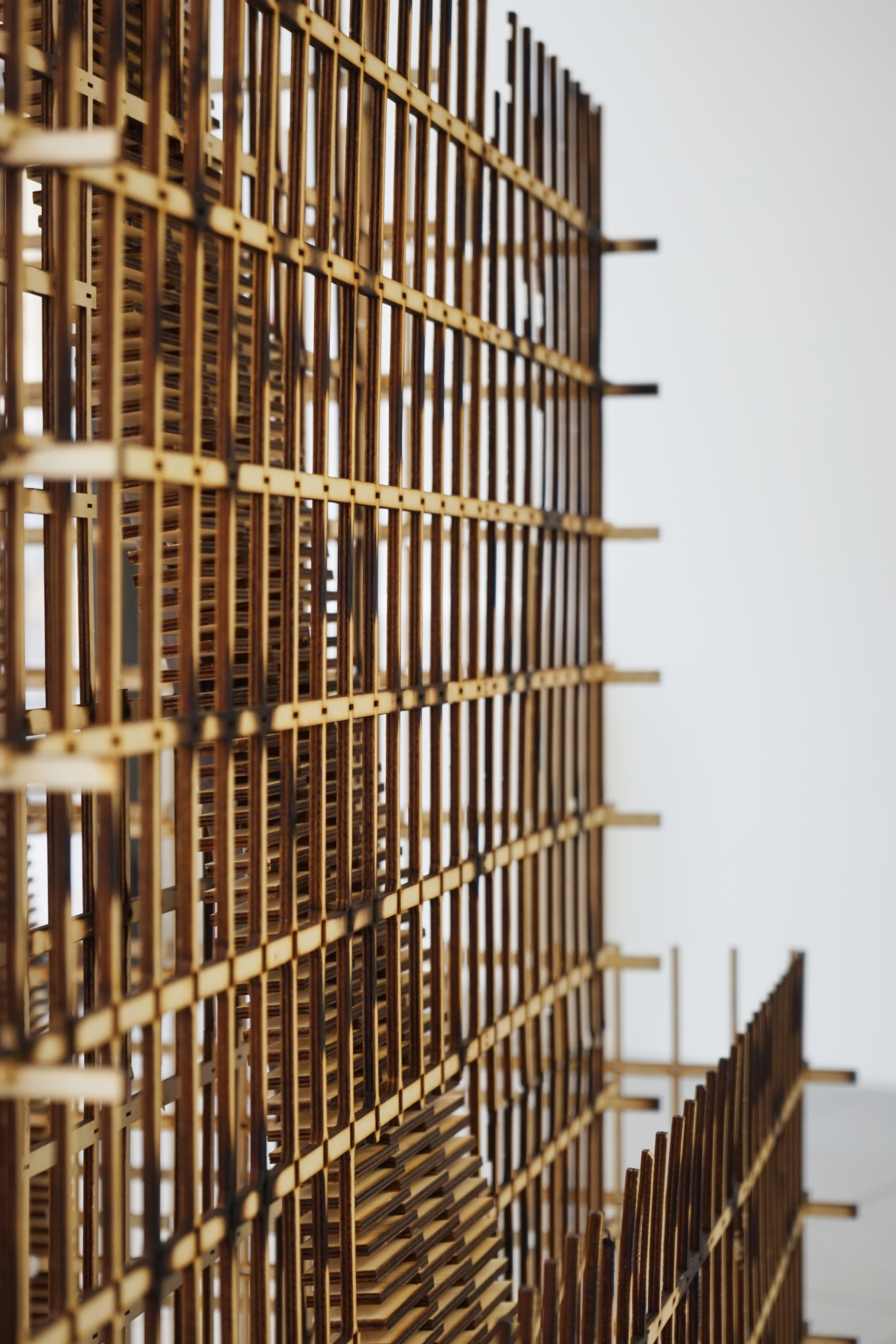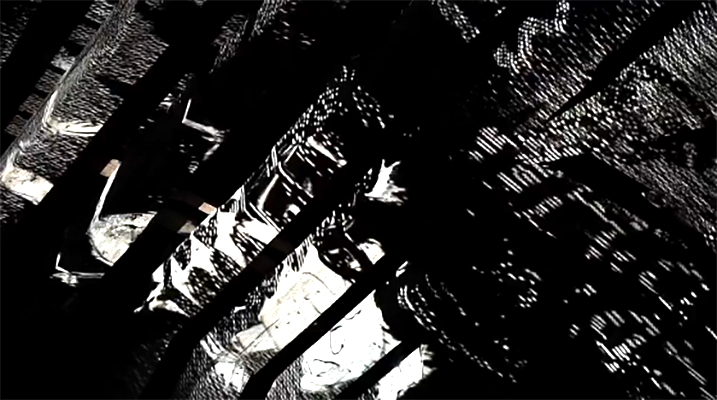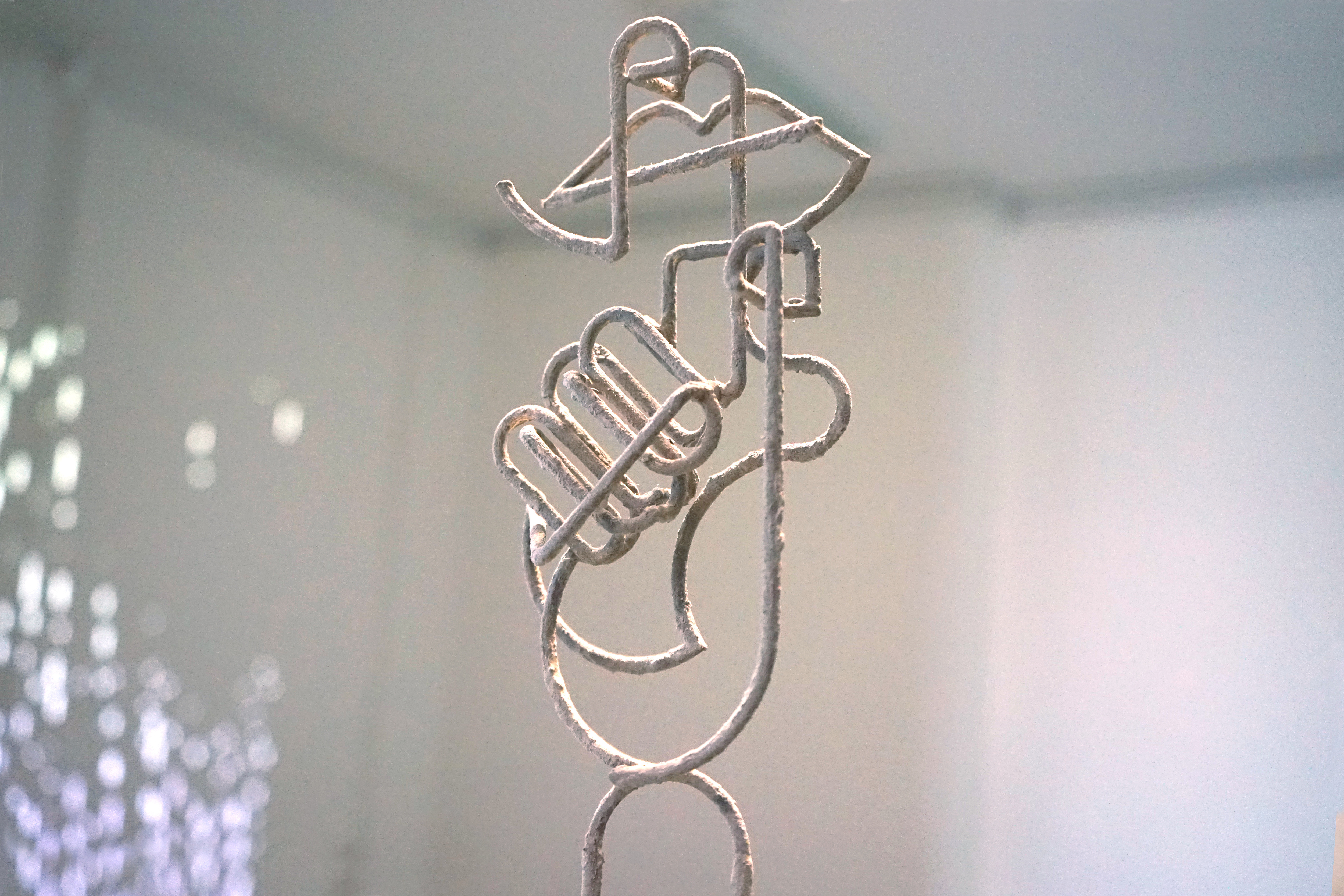@ Kommet (Lyon,69) du 24 Septembre au 20 Novembre 2021
Commissariat d’exposition : Emilie D’Ornano
Captation vidéo ︎︎︎ LSN Film
Merci à Bella Bates et Victor Hansemann
Texte
︎︎︎
Marianne Derrien
![]()
![]()
![]()
![]()
![]()
![]()
![]()
![]()
![]()
![]() L’interjection «Timber!», signifiant «Attention!»,
précède la chute imminente d’un arbre que l’on a entrepris de couper.
Utilisée par les bûcherons, cette injonction à se mettre hors de danger
désigne aussi, par extension, la charpente ou le charpentier.
L’interjection «Timber!», signifiant «Attention!»,
précède la chute imminente d’un arbre que l’on a entrepris de couper.
Utilisée par les bûcherons, cette injonction à se mettre hors de danger
désigne aussi, par extension, la charpente ou le charpentier.
Attention ! Une œuvre peut en cacher une autre. Comment apparaître et disparaître à la manière d’une TAZ, zone autonome temporaire ? C’est bien ce que Simon Lazarus semble entreprendre en ouvrant et en concluant son exposition T/MBER ! sur un entrelacement permanent de références, de faits historiques et de pratiques qui s’auto-génèrent et s’auto-détruisent. Sous les radars, Simon Lazarus a fait feu de tout bois pour parvenir à ses fins. Animé par une quête ardente de liberté de mouvement et d’expression, il a pratiqué le graffiti en parallèle de ses études en art et a participé en tant que membre du collectif Road Dogs à la «meute de voyageurs en partance pour les royaumes inconnus », qui explora l’Europe en montant clandestinement à bord de trains de fret. Dans la continuité de ces projets tant individuels que collectifs, Simon Lazarus a depuis affirmé une pratique qui allie dessin, sculpture et écriture. C’est grâce à elle qu’il garde bien vivante la mentalité transgressive, libre et aventureuse afin de les enfouir dans une certaine mélancolie quasi-cosmique. En désamorçant des technologies qui aseptisent et détériorent nos manières de vivre, il produit ses dessins avec des logiciels qu’il détruit après usage; ses sculptures se déforment ou sont prêtes à basculer dans une obsolescence programmée pour mieux nous faire sentir la catastrophe de l’ère industrielle et la fin de tous les enchantements.
Des mains travailleuses : biohacking versus biopouvoir
Un décryptage s’impose alors à nous. Depuis plusieurs années des sabotages d’émetteurs-récepteurs de 5G se multiplient en Europe sur arrière-plan de contestation politique. Tenter de comprendre les dynamiques qui animent une organisation clandestine ne peut se faire sans une attention très grande envers les dynamiques sociales et les équilibres politiques d’ensemble1. Une histoire de la clandestinité est ici en jeu tel un coup de grâce fait à la question matérielle de notre existence. En utilisant le système d’écriture Leet Speak, Simon Lazarus transforme l’écriture en mode hacker, brouille les lignes, sabote d’une manière graphique et poétique tant le sens que la forme. Il élabore une grammaire encodée dont les effets sont largement politiques. En se forgeant un autre langage, le titre de son exposition T/MBER !, terme utilisé par les bûcherons lorsqu’un arbre est prêt à tomber, intensifie ce cri d’alerte qui pose les fondements d’une relation ambiguë entre la construction et la chute d’une idée voire d’un système idéologique. Car bâtir, construire, détruire et déconstruire sont finalement des actions qui se contredisent et qui dialoguent à la fois. Chaque système engendre ses propres failles. Et toutes ces failles deviennent des espaces de liberté potentiels pour qu’une réinvention sociale puisse reconfigurer notre rapport collectif au travail. Le hacking associe le faire et la créativité en un enchevêtrement permanent entre innovations techniques et contre-cultures libertaires. C’est « la volonté de créer et de partager en se défaisant des contraintes imposées par le marché, la rentabilité, le droit de propriété »2.
Vue exposition T/MBER ! de Simon Lazarus, Kommet Lyon - Photo Simon LazarusVue exposition T/MBER ! de Simon Lazarus, Kommet Lyon – Photo Simon Lazarus
Plus dure sera la chute
Alors que tout semble s’effondrer selon certaines théories et approches actuelles, Simon Lazarus construit inlassablement quelque chose par lui-même en fabriquant ses propres outils et formes. Structure complexe et enchevêtrée de bois contreplaqué, Ponzi_Panorama se réfère, d’une part, à une charpente aux principes d’assemblages classiques en forme de pyramide qui semble bien ancrée au sol. Or ici rien n’est très stable, les morceaux de bois découpés au laser ont été en partie brûlés. À deux doigts de l’embrasement, un souffle suffirait à tout faire tomber. D’autre part, elle se réfère au système de Ponzi ou Pyramide de Ponzi, montage financier frauduleux qui consiste à rémunérer les investissements des clients essentiellement par les fonds procurés par les nouveaux entrants. Si l’escroquerie n’est pas découverte, elle apparaît au grand jour au moment où elle s’écroule, c’est-à-dire quand les sommes procurées par les nouveaux entrants ne suffisent plus à couvrir les rémunérations des clients. Elle tient son nom de Charles Ponzi qui est devenu célèbre après avoir mis en place une opération fondée sur ce principe à Boston dans les années 19203. Tant manuelle au sens artisanal du terme que cérébrale par ses formes géométriques imbriquées quasi-mathématiques, cette sculpture, entre ruine et maquette, vibre comme si elle allait s’écrouler quand on se déplace autour d’elle.
Un peu plus loin, posée au sol sur quelques morceaux de bois contreplaqués gisants comme des restes de la sculpture voisine, l’image d’un palmier continue à résonner avec la thématique boisée de l’exposition. Comme un piège qui nous serait tendu, il faut regarder à deux fois pour se rendre compte que ce palmier dissimule une antenne 5G. Entre biomimétisme et mascarade, le naturel flirte avec l’artificiel, le réel avec le mirage, le vivant avec la machine, la sève avec les ondes. Une boucle se boucle à travers cette image qui renvoie également à l’Hommage à des chauve-souris transmettant le feu. Toujours au sol à la manière d’une stèle funéraire, ce texte codé est un mixage des textes de l’artiste qui font écho au manifeste écrit par le collectif clandestin. Simon Lazarus use de multiples références tant historiques qu’artistiques et politiques afin d’en retenir quelques punchlines. Comme celles empruntées au best seller Sapiens de Yuval Noah Harari, Professeur d’Histoire à l’Université hébraïque de Jérusalem, qui mêle dans son ouvrage l’Histoire à la Science pour remettre en cause tout ce que nous pensions savoir sur l’humanité : nos pensées, nos actes, notre héritage et notre futur.
Vue exposition T/MBER ! de Simon Lazarus, Kommet Lyon - Photo Simon LazarusVue exposition T/MBER ! de Simon Lazarus, Kommet Lyon – Photo Simon Lazarus
Open source ou le Jardin des reliques
Bien plus qu’une exposition, T/MBER ! est une trappe qui nous invite à entrer dans un autre système ou à en sortir. Celui d’une grille qui est à la fois grillage, mur, mirage ou bien encore une matrice faite de lignes de construction ou d’une mise en page. Ce monde quadrillé est celui dans lequel nous évoluons et qui façonne notre relation à la ville, à l’espace urbain et à sa domestication. Pour contrer ces mondes, Simon Lazarus a su bâtir sa propre usine graphique et vivante avec les logiciels Open Source accessibles à toutes et tous. Ce type de logiciel est développé de manière collaborative et décentralisée et repose sur l’examen par les pairs. C’est toujours dans cette logique qu’il entreprend des petites sculptures faites de formes et de contre-formes en bio-plastique façonnées à l’aide d’une imprimante 3D selon différentes « recettes maison » avec des produits gélifiants. Ayant chacune leur couleur, leur plasticité et leur vitesse de dégradation propre, ces œuvres évoluent, s’altèrent, se décomposent tout au long de l’exposition.
En regard de ces natures mortes d’un autre genre en forme de fruits ou de bonbons, l’un de ses dessins est également pris dans une temporalité évolutive. À l’aide d’un robot pluggé au mur, Pollenisation est une œuvre contextuelle amenée à disparaître à la fin de l’exposition : un premier dessin au feutre est parasité petit à petit par un 2ème dessin au fusain. La surface murale se fait coloniser et génère d’elle-même les contours d’une cartographique imaginaire. Puis, nos yeux se lèvent au ciel pour contempler son Jardin_des_progrès où tout évolue et se transforme dans une course poursuite au progrès et de son mythe en écho au Jardin des délices de Bosch. Le triptyque historique semble avoir été ingurgité par des logiciels qui l’ont littéralement transmuté. Au sommet de ces dessins alchimistes de nos temps modernes, le soleil est converti en un vestige céleste de l’ère télévisuelle sous la forme d’une mire, qui brille dans l’attente d’une (r)évolution.
1 Virgile Cirefice, Grégoire Le Quang, Charles Riondet, La part de l’ombre: Histoire de la clandestinité politique au XXe siècle, Ed. Champ Vallon, Édition Époques, 2019, p.47
2 Michel Lallement, L’âge du faire, Hacking, travail, anarchie, Paris, Éditions du Seuil, 2015, p.12
3 Wikipédia https://fr.wikipedia.org/wiki/Syst%C3%A8me_de_Ponzi
![]()
![]()
![]()
![]()
![]()
![]()
![]()
Beware! One work can hide another. Or how to appear and disappear in the manner of a TAZ, a temporary autonomous zone. This is what Simon Lazarus seems to undertake by opening and closing his exhibition T/MBER! on a permanent interweaving of references, historical facts and practices that are self-generating and self-destructing. Under the radar, Simon Lazarus has been driven by an ardent quest for freedom of movement and expression, he practiced graffiti in parallel with his art studies and participated as a member of the Road Dogs collective in the "pack of travelers bound for unknown kingdoms", which explored Europe by clandestinely boarding freight trains. In the continuity of these individual and collective projects, Simon Lazarus has since affirmed a practice that combines drawing, sculpture and writing. It is thanks to this practice that he keeps alive the transgressive, free and adventurous mentality in order to bury them in a certain quasi-cosmic melancholy. By defusing technologies that sanitize and deteriorate our way of life, he produces his drawings with software that he destroys after use; his sculptures become deformed or are ready to fall into a programmed obsolescence to better make us feel the catastrophe of the industrial era and the end of all enchantments.
Working hands: biohacking versus biopower
A deciphering is then necessary to us. For several years now, sabotage of 5G transceivers has been multiplying in Europe against a background of political protest. Attempting to understand the dynamics that drive a clandestine organization cannot be done without paying close attention to the social dynamics and the overall political balance(1). A history of clandestinity is at stake here like a coup de grace to the material question of our existence. Using the Leet Speak writing system, Simon Lazarus celebrate syntaxe hacking, blurring the lines, sabotaging both meaning and form in a graphic and poetic way. He elaborates an encoded grammar whose effects are largely political. By forging a different language, the title of his exhibition T/MBER! a term used by lumberjacks when a tree is ready to fall, intensifies this warning cry that lays the foundations of an ambiguous relationship between the construction and the fall of an idea or even of an ideological system. For building, constructing, destroying and deconstructing are finally actions that contradict each other and dialogue at the same time. Each system generates its own flaws. And all these flaws become potential spaces of freedom so that a social reinvention can reconfigure our collective relationship to work. Hacking associates doing and creativity in a permanent entanglement between technical innovations and libertarian counter-cultures. It is "the will to create and share by getting rid of the constraints imposed by the market, profitability and property rights "(2).
The harder the fall
While everything seems to be falling apart according to certain current theories and approaches, Simon Lazarus tirelessly builds something by himself by making his own tools and forms. A complex and entangled structure of plywood, Ponzi_Panorama refers, on the one hand, to a framework with classical assembly principles in the shape of a pyramid that seems well anchored to the ground. But here nothing is very stable, the laser-cut pieces of wood have been partly burned. A breath of air would be enough to make everything fall. On the other hand, it refers to the Ponzi scheme or Ponzi pyramid, a fraudulent financial arrangement that consists of remunerating clients' investments essentially by the funds provided by new entrants. If the scam is not discovered, it becomes apparent when it collapses, i.e. when the sums provided by the new entrants are no longer sufficient to cover the clients' remuneration. It takes its name from Charles Ponzi, who became famous after setting up an operation based on this principle in Boston in the 1920s(3). Both manual in the sense of craft and cerebral in its geometric shapes, this sculpture, between ruin and model, vibrates as if it were going to collapse when you move around it.
A little further on, placed on the ground on a few pieces of plywood lying like the remains of the neighboring sculpture, the image of a palm tree continues to resonate with the woody theme of the exhibition. Like a trap set for us, we have to look twice to realize that this palm tree hides a 5G antenna. Between biomimicry and masquerade, the natural flirts with the artificial, the real with the mirage, the living with the machine, the sap with the waves. A loop is looped through this image that also refers to the "Tribute to bats transmitting fire". Still on the ground in the manner of a funerary stele, this coded text is an echo to the manifesto written by the underground collective. Simon Lazarus uses multiple historical, artistic and political references in order to retain some punchlines. Like those borrowed from the best seller Sapiens by Yuval Noah Harari, Professor of History at the Hebrew University of Jerusalem, who mixes in his work History with Science to question everything we thought we knew about humanity: our thoughts, our acts, our heritage and our future.
Open source or the Garden of relics
Much more than an exhibition, T/MBER! is a trap door that invites us to enter or leave another system. That of a grid which is at the same time a grid, a wall, a mirage or even a matrix made of construction lines or a layout. This gridded world is the one in which we evolve and which shapes our relationship to the city, to the urban space and to its domestication. To counter these worlds, Simon Lazarus has built his own graphic and living factory with Open Source software accessible to all. This type of software is developed in a collaborative and decentralized way and is based on peer review. It is always in this logic that he undertakes small sculptures made of forms and counter-forms in bio-plastic shaped with a 3D printer according to different "home recipes" with gelling products. Each with its own color, plasticity and speed of degradation, these works evolve, alter and decompose throughout the exhibition.
One of his drawings is also caught up in an evolving temporality, alongside these still lifes in the form of fruit or candy. With the help of a robot plugged into the wall, Pollenisation is a contextual work that will disappear at the end of the exhibition: a first felt-tip drawing is gradually parasitized by a second charcoal drawing. The wall surface is colonized and generates by itself the contours of an imaginary cartography. Then, our eyes are raised to the sky to contemplate his Jardin_Des_Progrès (Garden_of_Progress) where everything evolves and transforms in a race to progress and its myth in echo to Bosch's Garden of Delights. The historical triptych seems to have been ingested by software that literally transmuted it. At the top of these alchemist drawings of our modern times, the sun is converted into a celestial vestige of the televisual era in the form of a test pattern, which shines in expectation of a (r)evolution.
1 Virgil Cirefice, Grégoire Le Quang, Charles Riondet, La part de l'ombre: Histoire de la clandestinité politique au XXe siècle, Ed. Champ Vallon, Édition Époques, 2019, p.47
2 Michel Lallement, L'âge du faire, Hacking, travail, anarchie, Paris, Éditions du Seuil, 2015, p.12
3 Wikipedia https://fr.wikipedia.org/wiki/Syst%C3%A8me_de_Ponzi
Translated with www.DeepL.com/Translator (free version)

















ALL WORKS
2025. NEVER_TRUST_HAL_9000 - Video mural
2025. OWIMBOWE - Video mural
2024. DIYAUTO_ORCHESTRA - Installation
2023. BAZARNAUM_493 - Video mural
2022. OPECHO - LiveAV
2021. T/MBER! - Soloshow
2021. - Installation
2020. ABISNORR - Video mural
2020. UNAGI - Installation
2020. ECHO0 - Painting
2019. PONG - Video mural
2019. CENOTAPHE - Video Mural
2019. HANDACUMULUS - Video Mural
2018. FABULISM - Video Mural
2018. BURNOUT - Sculpture
2018. SHUTO - Sculpture
2018. GREYSCALE - Drawings
2018. GAMUT - Drawings
2017. OASIS_04515 - Video Mural
2017. TURBULENCE - Installation
2016. LOGORR - Installation
2016. BITMAP_PALACE - Drawings
2016. HUG - Sculpture
2014. ASCII - Installation
2012. N0TRE_D4ME - Hacking
2008. ECLIPSE - Hacking
︎
2025. NEVER_TRUST_HAL_9000 - Video mural
2025. OWIMBOWE - Video mural
2024. DIYAUTO_ORCHESTRA - Installation
2023. BAZARNAUM_493 - Video mural
2022. OPECHO - LiveAV
2021. T/MBER! - Soloshow
2021. - Installation
2020. ABISNORR - Video mural
2020. UNAGI - Installation
2020. ECHO0 - Painting
2019. PONG - Video mural
2019. CENOTAPHE - Video Mural
2019. HANDACUMULUS - Video Mural
2018. FABULISM - Video Mural
2018. BURNOUT - Sculpture
2018. SHUTO - Sculpture
2018. GREYSCALE - Drawings
2018. GAMUT - Drawings
2017. OASIS_04515 - Video Mural
2017. TURBULENCE - Installation
2016. LOGORR - Installation
2016. BITMAP_PALACE - Drawings
2016. HUG - Sculpture
2014. ASCII - Installation
2012. N0TRE_D4ME - Hacking
2008. ECLIPSE - Hacking
︎


















